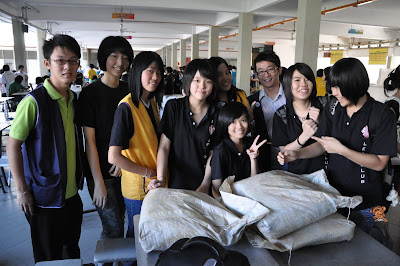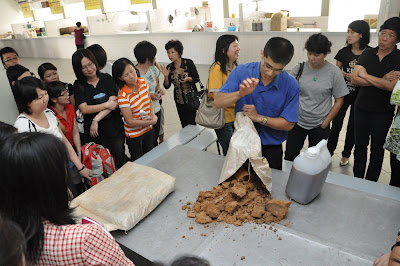DVP Ch'ng Kok Sheng, Leo Teoh Him Keat and Leo Kwang Min Xiang were visited Leo Club of Union High School's Effective Micro-organism Mud-Ball Making Project together with Leo Jocelyn Yew and Leo Cindy Teh from Leo Club of Tanjung(Penang) on the 31st July 2010 at their school.




The purpose of organized this project is to prepare the Mud-Balls for a coming event on this Sunday(8th August 2010).
There will be an EM Mud-Ball throwing ceremony, an initial 200k EM Mud-Balls will be throw into Gurney Drive beachfront and hope it will get back to the beauty of our beloved icon in a few months time.
What is EM(Effective Microorganisms)?
Effective Microorganisms, or EM is one of the most popular microbial technologies being used worldwide now. EM was first discovered by Dr. Teruo Higa, professor of horticulture at the University of the Ryukyus in Okinawa, Japan and it's products have been on the market since 1983.
By now EM is produced in over 54 countries and consists of naturally-occurring beneficial microorganisms. These microorganisms can easily be classified into three major groups: lactic acid bacteria (commonly found in dairy products), yeast (e.g. bread, beer), and phototrophic bacteria.
The use of Effective Microorganisms Technology has broadened in the last two decades from agriculture to water treatment, odour control, animal husbandry, human health, and numerous other industrial treatments.
Research has shown that the inoculation of EM cultures to the soil/plant ecosystem can improve soil quality, soil health, and the growth, yield, and quality of crops. Also when used in animal systems similar benefits have been shown. These microorganisms have a reviving action on growing systems and are completely safe to use.
A number of these microorganisms have long been familiar to the medical sector and the foods industry and are extremely useful for people, animals, plants, the soil and water. Naturally, EM Effective Microorganisms are not genetically engineered. Over the years, the completely harmless and safe nature of EM has been confirmed during a range of research both in Japan and other countries.
In general there are three types of microorganisms:
* Decomposing/degenerative microorganisms
* Opportunistic/neutral microorganisms
* Constructive/regenerative microorganisms
EM (Effective Microorganisms) belongs to the regenerative category. They can prevent decomposition in any type of substance and thus maintain the health of both living organisms and the environment.
Degenerative microorganisms behave in a manner that is diametrically opposite to that of the regenerative group.
The opportunistic/neutral microorganisms constitute the largest category. They follow the group which dominates in a system (See illustration below for a better understanding).
Therefore, when a milieu is created in which regenerative microorganisms prevail, the opportunistic microorganisms follow the constructive processes. Accordingly, the use of EM opens up completely new dimensions in many areas of our day-to-day existence. EM influences the microbial world in a way that ensures that regenerative microorganisms predominate. An environment is created in which by means of fermentation, microorganisms play a positive role with regard to plant growth and quality and soil fertility. Fermentation is stimulated with the result that decomposition disappears, i.e. soil is created in which regenerative microorganisms prevail, leading to optimum results, the prevention of disease and the production of high-quality products.
The employment of EM has met with an extremely positive echo among both conventional and organic farmers. EM cuts fertiliser costs and in the course of time also reduces the volume of weeds. As EM effective microorganisms work largely in the anaerobic sector and they are especially effective in areas where problems such as putrefaction, mal odours and sludging occur.
Effective Microorganisms are utilised in arable farming, vegetable production, fruit farming and viniculture. EM in ponds, biotopes and fish breeding waters bring both an improvement in water quality and sludge degrading. The microorganisms in EM are able to convert the decomposing material derived from the settling of organic matter such as leaves, algae, pollen, seeds, fish food, etc. This optimises the water quality and furnishes an excellent environment for fish breeding.





No comments:
Post a Comment